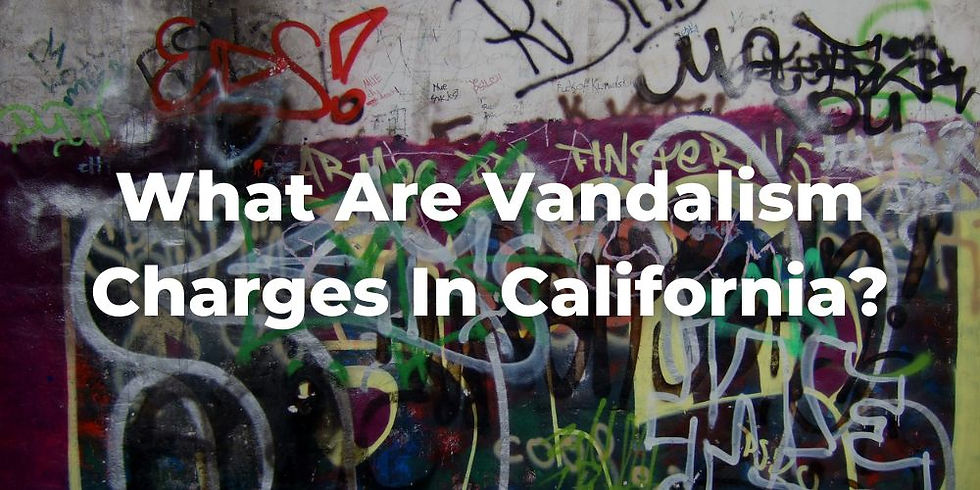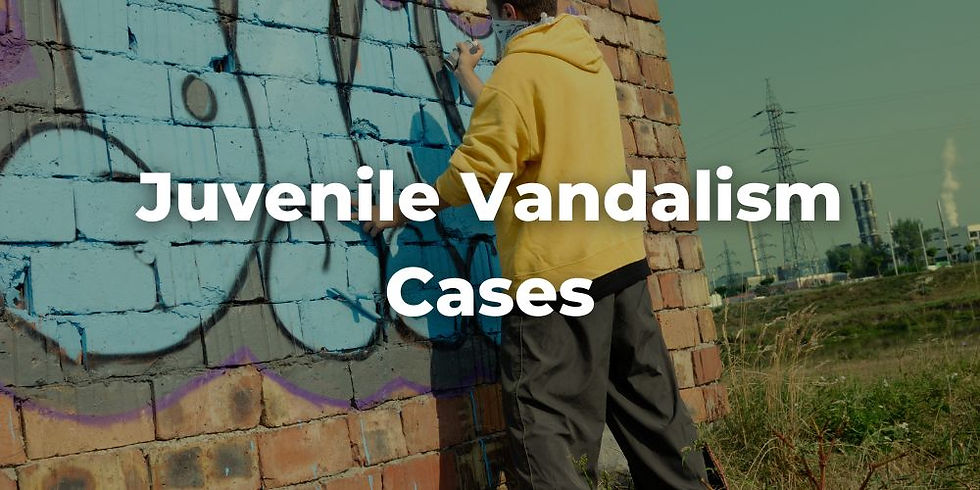How to Expunge Vandalism Charge in CA Properly
- Blair Goss

- Mar 3
- 5 min read
A vandalism conviction can affect a criminal record and lead to difficulties in employment, housing, and other opportunities. The consequences can follow someone for years, whether the charge involves graffiti, minor property damage, or more serious vandalism offenses.
California law provides a way to move past these challenges by expunging a vandalism charge and clearing the conviction from public records. This article explains and answers the question, "How to expunge vandalism charge in CA" by outlining the steps, who qualifies under the law, and the benefits of clearing a criminal record. Our team is also able to assist with how to expunge brandishing charge in CA.

What Are Vandalism Charges in California?
Under California Penal Code 594, vandalism is damaging, defacing, or destroying someone else’s property without permission. Common examples include graffiti, breaking windows, or damaging cars. Vandalism in California can be classified as either a felony or misdemeanor vandalism, depending on the cost of the damage.
If the damage is less than $400, it is typically classified as a misdemeanor. This may result in fines, a county jail sentence, probation, or community service. However, if the damage exceeds $400, the charge escalates to a felony, which can lead to higher fines and time in a California state prison.
Penalties often depend on whether the person has a prior vandalism conviction. These charges are serious because they can leave lasting marks on a criminal record and affect future opportunities. Everyone needs to understand these consequences, especially for cases involving minors in the California juvenile court system.
What Is Expungement, and Who Qualifies for It?
Expungement is the legal process of clearing a criminal record. It allows someone to have a past vandalism conviction or other criminal offense dismissed. This makes it easier to apply for jobs, housing, or loans. Once a record is expunged, most employers or landlords won’t see the conviction on background checks.
Under California Penal Code Section 1203.4, someone may qualify for expungement if they:
Successfully completed probation, including all fines, community service, or other conditions.
Have no open criminal cases or ongoing jail sentences.
Expunging a misdemeanor conviction is generally simpler than a felony conviction, but even felony vandalism charges can sometimes be cleared. The key difference is that felonies might require additional steps, such as reducing the charge to a misdemeanor before expungement.
Essentially, expungement doesn’t erase a record entirely but offers a fresh start by removing convictions from public view. This step can be life-changing for many people. Goss Law can also advise on how to expunge larceny charge in CA.
Eligibility for Expunging a Vandalism Charge in CA
Under the law, certain requirements must be met to expunge a vandalism conviction. These include completing all terms of probation, such as paying fines, finishing community service, or attending counseling. There must also be no additional criminal convictions, and at least one year must have passed since the sentence was completed if no probation was involved.
Expungement may be denied in some cases. For example, violating probation is a common reason for denial. Also, certain felony offenses, especially those considered "strike offenses" under California law, might not qualify.
This process applies to both misdemeanor and felony vandalism, but the complexity increases with more serious charges. Consulting a criminal defense attorney can clarify whether someone is eligible based on the specific circumstances. Clearing a California criminal record can help reduce the lasting impact of a vandalism charge on future opportunities.
Steps to Expunge a Vandalism Conviction
Expunging a vandalism conviction in California involves a simple process, but each step must be followed carefully to improve the chances of success.
Step 1: Reviewing Eligibility
The first step is to check the criminal record to confirm that the vandalism charge qualifies under California's vandalism laws. Charges such as misdemeanor vandalism or certain felony offenses can often be expunged if probation was successfully completed and there are no additional criminal convictions.
Step 2: Gathering Documents
Collecting the right documents is important. These may include court records, probation details, and proof that all required conditions, such as fines or community service, have been completed. Essentially, these records show the court that all terms were fulfilled.
Step 3: Filing a Petition
A formal expungement petition must be filed with the court where the conviction occurred. The team at Goss Law can assist in ensuring the paperwork is accurate and submitted on time, which helps to avoid unnecessary delays or errors.
Step 4: Attending the Hearing
Some cases require a court hearing. If this happens, the person must explain to the judge why they want to clear their record. They usually need to show that they have changed and followed all legal rules.
Step 5: Waiting for the Court's Decision
After the hearing, the court will decide to either approve or deny the expungement. Approval clears the conviction from public records and offers a fresh start. A denial might occur if probation terms were violated or other disqualifying factors exist.
Effects of Expungement on a Criminal Record
Expungement removes a conviction from public records, which means it won’t appear in background checks for most employers or landlords. However, it doesn’t erase the conviction from law enforcement databases or guarantee that professional licensing boards will ignore it. For more information, expungement attorneys in Sacramento may be able to help.
The benefits of expungement include the ability to legally state no prior criminal convictions on most applications. This can improve a person's chances for better job and housing opportunities.
For charges such as violating California’s vandalism law or petty theft, expungement can provide a clean slate and help move past the impact of a jail or prison sentence.

Special Considerations for Juvenile Vandalism Cases
In the California juvenile court system, vandalism charges for minors are treated differently than adult cases. These cases focus more on rehabilitation than punishment, often involving counseling, community service, or probation.
If all conditions are met, there may be an option to seal the juvenile record, which can prevent the charge from affecting future opportunities. Early legal help is important to reduce long-term consequences. A skilled criminal defense attorney can guide the process and make sure the minor’s future is not permanently affected by a mistake.
Closing Thoughts
Expunging a vandalism charge can clear a criminal record and open the door to better opportunities. Whether the charge was a misdemeanor or a felony, taking steps to expunge it can help someone move forward. The process is manageable with the right guidance.
At Goss Law, we work hard to help people clean up their records and move past mistakes, whether involving vandalized property or other charges. Call us for a free consultation. Let’s discuss how we can help with your case.

Comments